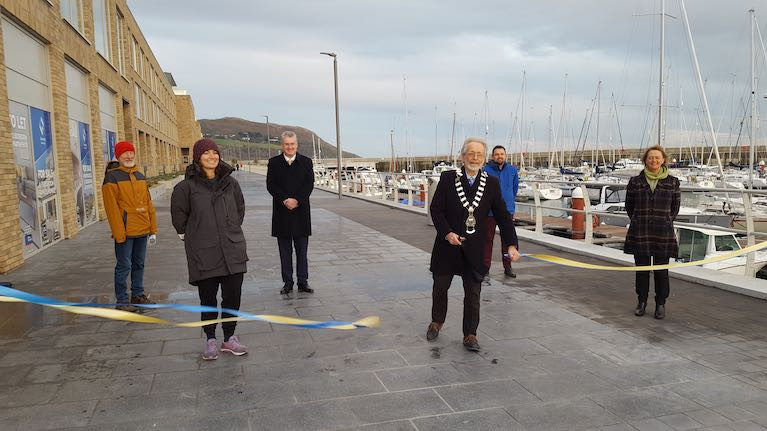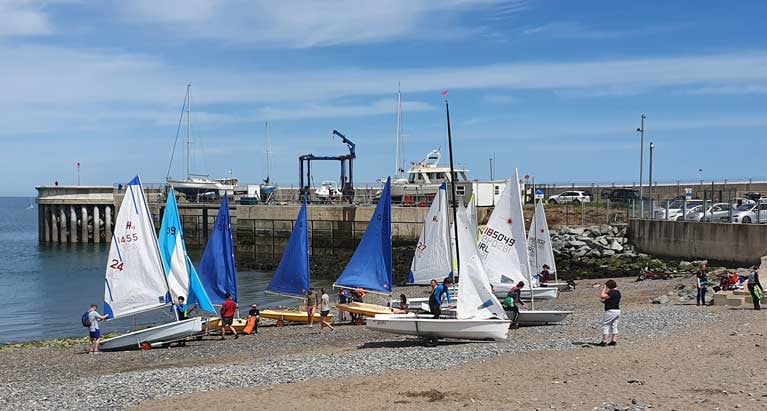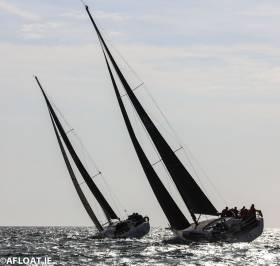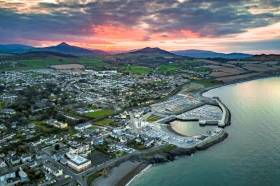Displaying items by tag: Greystones Harbour
Greystones Sailor Competing at OK World Champs in Brisbane
Greystones Sailing Club ex-pat Sean Cleary was in the top ten of the OK world championships at the Royal Queensland Yacht Squadron in Brisbane, Australia, but a DSQ originally reported initially as a fourth (before protest) has proved unfortunate.
Nick Craig and Andy Davis traded race wins on the penultimate day. They top the leaderboard, separated by just six points, with Australia’s Roger Blasse – who had the joint best day with Davis – another four points behind. Just two races remain on Saturday.
Now sailing under the flag of New Zealand, Cleary is in 23rd but hoping the 1 and 3 scored in the qualifies can still help to bring him up overall.
Royal Irish's Tim Goodbody, who did well in Europeans last year didn’t travel to Queensland.
The top of the fleet remains tight going into the final day. It would be a brave man to bet against Craig winning his sixth OK Dinghy world title, but with a 20th on the board, and with the way Davis and Blasse are sailing, he cannot afford another slip up. Davis is sailing exceptionally well and while he won the British championship last year, he is a relative newcomer to the class. Meanwhile, Blasse is a double world champion and is within striking distance. It is a long way from over.
Greystones Harbour Marina Adds 56 Berths
Greystones Harbour Marina in County Wicklow has announced that 56 berths have been added to the marina as part of a scheduled expansion.
The additional berths range from 6m to 20m and are available for use immediately.
As was the case when the marina first opened in 2013, Inland and Coastal Marina Systems were the pontoon manufacturers of choice at Greystones.
"Working with an Irish-based company ensured that the work was carried out most efficiently, backed up by local support post installation. The changeable October weather was not an issue for the team on site, James Kirwan of Greystones Harbour Marina told Afloat.
 Greystones Harbour Marina
Greystones Harbour Marina
This is the second major development at Greystones Harbour Marina in 2023 after the installation of a fuel supply at the marina, both petrol and diesel.
"We look forward to welcoming visitors from near and far to Greystones Harbour Marina, Kirwan adds.
Greystones Crew on 'Usain Boat' are Crowned 2023 Hunter Formula One Irish Champions
While looking for a cost-effective option for one design small keelboat racing, a group of members from Greystones Sailing Club got together and identified the Hunter Formula One as a solution. Over the winter of 2022/2023, four boats were bought up, and maintenance or upgrades were carried out.
As part of the Taste of Greystones Regatta, the new local class was given its own start, and six boats competed, welcoming Martin Mahon and his Snoopy Race team, travelling up from Courtown Sailing Club as the only visitor. A fifth local boat was purchased on the Wednesday before the event and quickly put together to make the start. The Greystone U25s team also competed in their Formula One with great individual race results.
The Irish championships consisted of five windward-leeward races.
Racing proved to be very tight, with only one point separating second, third and fourth positions overall.
 Six boats contested the Hunter Formula One Championships at Greystones Harbour
Six boats contested the Hunter Formula One Championships at Greystones Harbour
Speaking about the weekend, the Greystones-based Hitch Hiker (Frank O'Rourke/Graeme Noonan - second overall) crew said, “We had great one-design close racing. Plenty of places changing throughout the races kept it interesting for all involved.”
The Bitz team (Dara McDonagh/ Jonathon Sutton) also noted, “It was a brilliantly organised weekend of racing and great to see the revival of a fleet I grew up racing in. The boats are light and nimble, providing close racing with numerous lead changes per race.”
The overall winners were Usain Boat, from Greystones Sailing Club, with a crew of Rachel O’Leary, Marty O’Leary, Paddy Blackley and Tom Moran.
Barry Cunningham's brand new Cape 31 Blast topped Class One of the Taste of Greystones Regatta off the Wicklow coast on Sunday.
The Royal Irish Yacht Club skipper beat a fleet of 12 in the no discard two race series with two clear wins.
In second place was Brian Allen's J122 Javeline, with third overall going to the Howth and Rush J109 Storm (Pat Kelly).
 Barry Cunningham's brand new Cape 31 Blast won the Taste of Greystones Regatta with two wins in Class One
Barry Cunningham's brand new Cape 31 Blast won the Taste of Greystones Regatta with two wins in Class One
 Taste of Greystones Regatta 2022 Class 1 Overall Sailed: 2, Discards: 0, To count: 2, Rating system: IRC, Entries: 12
Taste of Greystones Regatta 2022 Class 1 Overall Sailed: 2, Discards: 0, To count: 2, Rating system: IRC, Entries: 12
 (Above and below) Some of the 41 yachts racing in the 2022 Taste of Greystones Regatta off Wicklow
(Above and below) Some of the 41 yachts racing in the 2022 Taste of Greystones Regatta off Wicklow

In Class Two, Frank Whelan's Corby 25 Fusion of the host club was the overall winner in a seven-boat battle, but not until a protest and the tie-break rule decided the matter.
Second was James Ryan's Formula 28 Imprint, also on four points.
Third was John Sugars' Dublin Bay-based 31.7, Attitude on eight points.
 Class Two Taste of Greystones winners: (from left) Frank Whelan, skipper of the Corby 25, Paddy Barnwell, Killian Fitzgerald and Brian Hare Photo:Hadrian Fawsitt
Class Two Taste of Greystones winners: (from left) Frank Whelan, skipper of the Corby 25, Paddy Barnwell, Killian Fitzgerald and Brian Hare Photo:Hadrian Fawsitt
 Taste of Greystones Regatta 2022 Class 2 Overall Sailed: 2, Discards: 0, To count: 2, Rating system: IRC, Entries: 12
Taste of Greystones Regatta 2022 Class 2 Overall Sailed: 2, Discards: 0, To count: 2, Rating system: IRC, Entries: 12
 Charles Heather's Flashpoint, a Starflash 25, was third in Class Three of the Taste of Greystones Regatta
Charles Heather's Flashpoint, a Starflash 25, was third in Class Three of the Taste of Greystones Regatta
In Class Three, the biggest fleet of the regatta, Paul Wafer's Quartertonner, Quartermaster was the clear overall winner with two wins from two races from Kieran O'Byrne's Impala, Huntress.
Third, on an equal seven points, was Charles Heather's Flashpoint, a Starflash 25.
 Taste of Greystones 2022 Regatta Class 3 Overall Sailed: 2, Discards: 0, To count: 2, Rating system: IRC, Entries: 14
Taste of Greystones 2022 Regatta Class 3 Overall Sailed: 2, Discards: 0, To count: 2, Rating system: IRC, Entries: 14
The non-spinnaker nine-boat division was won by Tom Dunne's Sunfast 35, Katienua.
 Taste of Greystones Regatta 2022 Non Spinnaker Overall Sailed: 2, Discards: 0, To count: 2, Rating system: IRC, Entries: 9
Taste of Greystones Regatta 2022 Non Spinnaker Overall Sailed: 2, Discards: 0, To count: 2, Rating system: IRC, Entries: 9
Greystones J/122 Kaya Dominates Class Zero at ICRA Nationals
Greystones Sailing Club's J122 Kaya is walking away with the IRC Zero Divison of the ICRA National Championships, counting four wins from four races so far.
“The boat is going very well, and we got good positions most of the time,” Kaya tactician Mark Mansfield said. “With a good crew, the results just came. And we’re the middle-rated boat in our class.”
The Wicklow crew are Frank Whelan (helm); Paddy Barnwell (nav/helm); Mark Mansfield (tactics), Andy Verso (main); Bill Nolan (trim 1); Cillian Ballesty (trim 2); Gary Hick (pit1); Matt Sherlock (mast); Gavin Laverty (bow 1); Brian Hare (bow 2) and Killian FitzGerald (pit2)
The regatta reaches its conclusion on Sunday, and some well-publicised challenges for the Zero title have not materialised.
Although a pre-race favourite, Conor Phelan's Ker 37 Jump Juice took a UFD penalty in the first of three races today, putting her into fifth overall on 22 points.
Another challenge from June's Sovereign's Cup-winning Grand Soleil 44 Samatom ended after a weather mark collision in race two saw the brand new marque retire from racing today.
 Another great start for Kaya in the ICRA big boat class, but spare a thought for smaller Class Zero competitors such as second-row Yoyo, the Sunfast 3600, some 10 feet smaller than the biggest entry
Another great start for Kaya in the ICRA big boat class, but spare a thought for smaller Class Zero competitors such as second-row Yoyo, the Sunfast 3600, some 10 feet smaller than the biggest entry
Instead, Jay Colville’s Forty Licks from the Royal Ulster Yacht Club has been a consistent presence in the 12 boat fleet and is rewarded with second place overall on 10 points.
 Jay Colville’s Forty Licks from the Royal Ulster Yacht Club is second overall.
Jay Colville’s Forty Licks from the Royal Ulster Yacht Club is second overall.
Another Northern Ireland boat, the Beneteau 40.7 Game Changer, lies third on 19 points.
 The Beneteau 40.7 Game Changer from Cockle Island Boat Club lies third
The Beneteau 40.7 Game Changer from Cockle Island Boat Club lies third
The forecast for Sunday's final two races is for SSE winds of 12 to 16 mph
Results are here
 The Dublin Bay First 40 Prima Forte from the National Yacht Club lies fourth.
The Dublin Bay First 40 Prima Forte from the National Yacht Club lies fourth.
 El Pocko, a Puma 42 from the Royal St George Yacht Club
El Pocko, a Puma 42 from the Royal St George Yacht Club
Wicklow RNLI Lifeboat Tow Fishing Boat to Safety
Wicklow RNLI lifeboat brought two fishermen to safety today after their vessel developed engine trouble six miles east of Greystones harbour.
The all-weather lifeboat under the command of Coxswain Tommy McAulay was tasked by the Coast Guard at 12:15pm and proceeded north to assist the fishermen.
The seven-metre fishing vessel with engine failure was located thirty minutes later, near the East Codling Buoy. Conditions on scene were sea state slight with good visibility. A towline was passed to the fishing vessel and a course was set for Greystones Harbour.
The fishing vessel was brought alongside at Greystones harbour and the two crew were landed safely ashore just before 2pm this afternoon.
Greystones Boardwalk & Coastal Park Opened in County Wicklow
A new coastal park and boardwalk overlooking Greystones Marina were opened last week by Cllr Derek Mitchell, Cathaoirleach of Greystones Municipal District in the presence of Frank Curran, Chief Executive of Wicklow Council Council and Pamela Lee who set the Round Ireland 2 Handed Sailing Record from Greystones Harbour. The boardwalk, which is over 300 metres long, links the coastal park to Greystones Harbour, with the two newly opened amenities forming an integral part of the Bray to Greystones Cliff Walk, which runs from the Bray Promenade to the Harbour Square, Greystones.
Commenting on the project Cllr Mitchell said “I am delighted the entire harbour project is now virtually complete. It has transformed a derelict harbour into a community focal point for a large town with the boardwalk being a key visual feature forming a line with Trafalgar Road pointing towards Bray Head”. Cllr Mitchell went on to state “the €300 million development provides excellent promenades, substantial north and south breakwaters, a 200 berth marina, 2 public slipways, club facilities for sea scouts, rowers, divers, sailors and anglers, as well as 340 homes on what was a Brownfield site”. The Cathaoirleach of Greystones Municipal District concluded by saying “he hoped the final small block of retail space and 33 apartments would be completed within 2 years”.
 The new Greystones Harbour boardwalk
The new Greystones Harbour boardwalk
Speaking after the opening the Chief Executive of Wicklow County Council, Frank Curran, said “today’s opening represents a significant milestone in the Public Private Partnership (PPP) between Wicklow County Council and SISPAR. The project has revitalised and expanded Greystones Harbour and made it a central feature of the town, as well as providing an ultra-modern facility with the deepest marina on the east coast”.
Mr Curran went on to note “the last harbour constructed on an open coast in the country was Rosslare Harbour in 1906, which makes this a rare project and a complex one for the Council to have implemented”.
Taking advantage of the glorious weather and the lifting of restrictions, Greystones Sailing Club launched a fleet of 37 dinghies last Saturday, and another 18 went out last night (Thursday). This was the second week of a race training programme organised by the club aimed at single handed and double-handed from the same household sailors.
The usual fleet of RS 400s, 200s and Fevas was boosted by an exploding fleet of Lasers recently added to the club, not to mention a number of adults who shoe-horned themselves into the clubs fleet of Laser Picos as the only option for sailing under the current Irish Sailing advisory.
 A fleet of RS 400s, 200s and Fevas was boosted by a new fleet of Lasers at Greystones Harbour
A fleet of RS 400s, 200s and Fevas was boosted by a new fleet of Lasers at Greystones Harbour
Managing what she described as “quite a logistical challenge” club Commodore, Daphne Hoolahan patrolled the beach ensuring that all participants were signed in and out to comply with contact tracing requirements. The fleet took part in a series of practice starts and sprint races.
 An RS Aero (right) is part of the dinghy scene under the Sugerloaf at Greystones Bay
An RS Aero (right) is part of the dinghy scene under the Sugerloaf at Greystones Bay
Coaching organiser, Fiachra Etchingham, was delighted with the outcome. “As Saturday progressed, you could see significant improvement in our sailors who’d had a longer than usual off season” he commented. “The current restrictions have compelled us to do something we do so little of, train for our sport!”
The training programme will continue in the coming weeks with North Sails Shane Hughes being lined up for a master class in due course.
Greystones Regatta Falls Flat for Need of Wind
After so much promise with sun-filled races towards Greystones on Saturday, as a local observer has wrily remarked, Sunday was more Factor 6 than Force 6…….Perhaps in other places, local coastal anomalies and neighbourhood weakness in tidal streams made events possible. But off Greystones, you need a good working breeze to deal with those very real tides, and the summery weekend’s entire allocation of wind for Greystones seems to gave been used up by late Saturday afternoon.
Thankfully, most competitors had experienced good racing in the sunshine on Saturday in the many feeder races that have become a key part of the Taste of Greystones event. With Saturday night partying at many locations ashore and aboard boats in the marina much in evidence, there were some who said that a lack of racing on Sunday was no great loss. But as the results of the feeder races show, there were some serious competitors heading towards the hospitable North Wicklow port looking to strut their stuff in the combined fleet programme on Sunday morning.
Admittedly the very light or non-existent wind forecast for Sunday’s wind had kept numbers down a bit, but even so 25 yachts raced from Dublin Bay, ten from Poolbeg, they raced from Clontarf too, while eight more from Wicklow swelled the fleet to a significant number when added to the high-powered 14 who’d sailed in the early-start ISORA race. But the fresh winds winds that had initially favoured the South-bound boats were not so kind to the Arklow boats which had to motor to Greystones after experiencing the same wind hole as the later-arriving ISORA boats off North India Buoy, a wind hole which saw its mission in life as being a general expansion of calm with mist for Sunday morning
Thus the morning so keenly anticipated offered wind with no visibility, or visibility with no wind, and the Race Officer had little choice but to invite all to zip up the sailbags and head to the clubhouse for the complimentary lunch.
A fine lot of crystal and silver waits for a good home, and Greystones SC hope to rerun the event in some form or other, but maybe not this year as a very crowded fixture list makes September and early October difficult to navigate. Though the thinking behind a Taste Of Greystones Regatta is as a seasonal ender to mark the rich harvest in the Garden County, GSC Regatta in 2019 had too much of the mists and mellow fruitfulness and calm of early Autumn, and not nearly enough of the wind that shakes the barley. So the club may rerun yesterday’s races as a season opener in 2020, on the Sunday before club racing commences along the East Coast.
Details will be shared with all entrants as they become clearer.
Feeder Races Results
Poolbeg Class 1 1st Chipita 2nd Extension
Class 2 1st Black Opel 2nd HillyBilly
Clontarf 1st Wylie Coyote 2nd Enchantress
Wicklow 1st Big Cheers 2nd Ruff Nuff
ISORA 1st Eleuthera 2nd Aurelia
DBSC Class 1 1st White Mischief 2nd Gringo
Class 3 1st Dubious 2nd Starlet
Class 5 1st Shearwater 2nd Katienua
BJ Marine 'Taste of Greystones' Regatta This Weekend Celebrates a Unique Town & Harbour
The problem with Greystones is that it faces the sea writes W M Nixon. Or at the very least, there isn’t a part of the north Wicklow town in which you aren’t very aware that the sea is nearby. The Victorian and Edwardian enthusiasts for sea-air breathing and salt-water bathing who turned this quaint fishing village into a niche seaside resort and healthy residential area would scoff at the idea that always facing the sea in this way was a “problem”. But we’re talking about the optics here, folks.
The thing is that, when you’re in Greystones, you’re somehow unaware that it is located at the heart of one of the most scenically-blessed parts of Ireland. In fact, in looking at a selection of aerial images of Greystones as it snuggles by the coast in close relation to the most wonderful mixture of farm and woodland and uplands and fascinating purple mountains which draw the eye over the hills and far away, you could be forgiven for thinking this is the most beautiful part of Ireland, full stop. And in fact, you might well be right.
Yet in the old days, only the occasional lone aviator and those of us sailing past were fully aware of this magnificent backdrop to the little town. And as the harbour was a somewhat ramshackle affair based around the re-cycling of the failed first attempt to build the Kish Lighthouse (even here, we don’t have the space to tell the full story of that extraordinary saga), any passing cruising yacht was reluctant to go into the tiny, shallow, rough and ready small-boat-packed haven and tell the clientele at the harbourside Beach House what an utterly fantastic place they lived in.
However, some locals did appreciate it properly. Greystones Sailing Club celebrated its Golden Jubilee last year, and among its founder members were the parents of current Irish Sailing President Jack Roy, who cut his own sailing teeth in Greystones, still thinks of the place as home, and was Guest of Honour among a convivial crowd of distinguished folk from every walk of north Wicklow life at the 50th Anniversary party in June 2018.
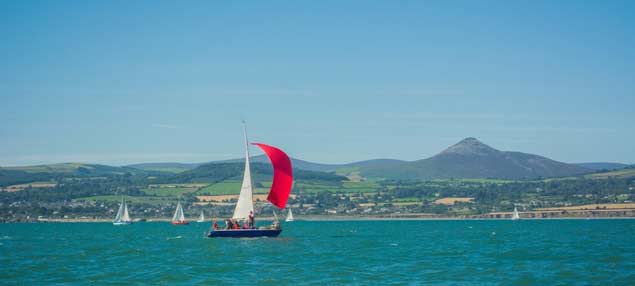 What a backdrop for sailing……Greystones provides good racing off one of the most beautiful coastlines in Ireland, and now it has a proper harbour to facilitate full enjoyment of its attractions and hospitality for visiting boats. Photo GSC
What a backdrop for sailing……Greystones provides good racing off one of the most beautiful coastlines in Ireland, and now it has a proper harbour to facilitate full enjoyment of its attractions and hospitality for visiting boats. Photo GSC
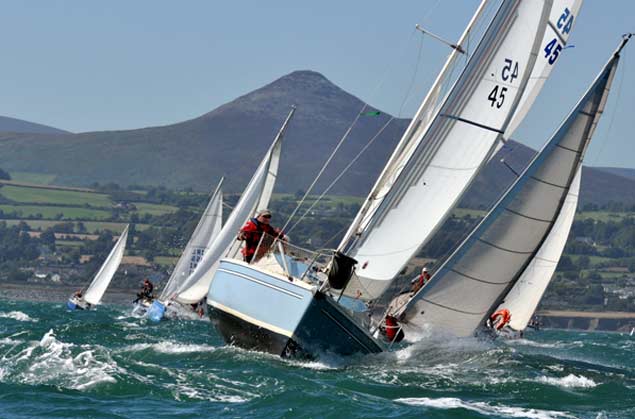 And if anything, that coastline looks even more impressive when there’s a bit of a breeze. Photo GSC
And if anything, that coastline looks even more impressive when there’s a bit of a breeze. Photo GSC
But the Greystones Harbour area of 2018 and 2019 is a very different waterfront place from the Greystones of 1968 when the new sailing club began to stake its claim to a place along the beach and a compound to keep its sailing dinghies, plus a bit of space in the tiny harbour for its flotilla of small cruisers. For Greystones Harbour is now a proper marina with complete shoreside facilities run by BJ Marine and a shared clubhouse beside a spacious and secure dinghy park.
Progress towards this vibrant state of affairs has of course not always been smooth, particularly as key parts of it were happening during the Great Recession of a decade ago. But now, instead of being a place you sailed past and marvelled at the scenery in which it is set, it has become a destination harbour three times over.
For it is not only a strategically located and totally sheltered haven, conveniently near Dublin yet far enough away to stand out as a place in its own right, it’s also a gastronomic destination from land and sea, with attractions to suit foodies and gourmets of all persuasions, together with those who just like a hospitable and friendly place serving decent pints and good home-cooked fare. And on top of all that, Greystones Sailing Club has become a pace-setter on the national scene.
Commodore Daphne Hoolahan leads an enthusiastic membership with a formidably talented lineup of specialist officers, and while it may be unfair to single out individuals, when you have people of the calibre of Monica Schaefer as Honorary Sailing Secretary and Daragh Cafferky as the man in charge of keelboats and clubhouse matters, not to mention Norman Lee as Honorary Club Bo’sun in addition to managing the dinghies, then it’s clear we’re dealing with efficient can-do people, rather than dreamy ’twill-do folk.
The results bear it up. Just last weekend, Greystones’ own Shane McCarthy, crewed by clubmate Damien Bracken, regained the Irish GP 14 National title in blustery conditions at Skerries against a truly international fleet which reflected the fact that in 2020, Skerries will be hosting the International GP 14 Worlds.
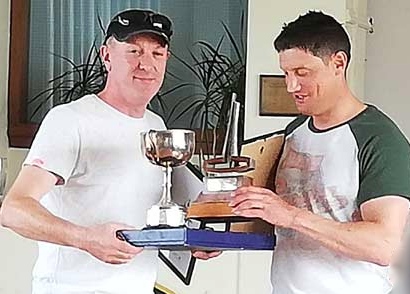 Damien Bracken (left) and Shane McCarthy of Greystones with their trophies after the latter had helmed their way to overall victory from an international fleet at the Irish GP 14 Nationals in Skerries last weekend. Photo SSC
Damien Bracken (left) and Shane McCarthy of Greystones with their trophies after the latter had helmed their way to overall victory from an international fleet at the Irish GP 14 Nationals in Skerries last weekend. Photo SSC
But Skerries can only envy Greystones in its soaring success, for the Fingal port bears much the same relationship to the Greater Dublin area to the north as Greystones does to the south. Yet while Skerries continues to struggle to persuade the powers that be that its primitive harbour badly needs development to allow water and boat sports to grow properly and safely, Greystones sails securely on with confidence in a proper harbour.
And 2019 saw the Greystones hosting of a world dinghy championship too. The fact that it was the Wayfarer Worlds in July is in the best-established traditions of Greystones as something of a niche place, for the superb 16ft Ian Proctor-designed Wayfarer would be much more popular globally if more people were aware of its exceptional versatility - excellent club racing and a record of Icelandic and trans-North Sea voyaging are only two of its many attributes.
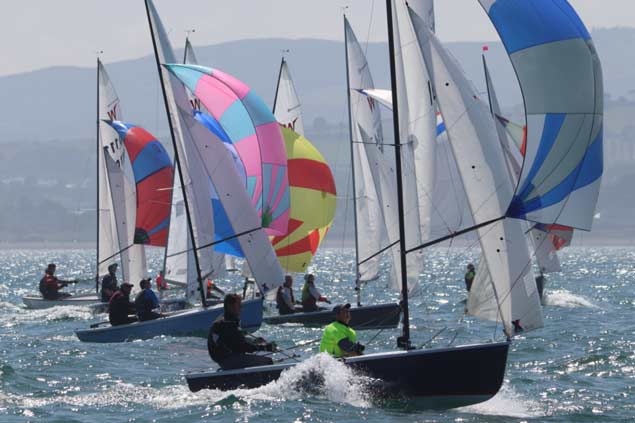 The versatile Wayfarers having magnificent sailing in their Worlds at Greystones, July 2019. Photo Alan Jones
The versatile Wayfarers having magnificent sailing in their Worlds at Greystones, July 2019. Photo Alan Jones
But Wayfarer people are a special crowd, they prefer personal quality to mindless quantity in the crews they race against. Yet even with that selective approach, the 2019 International Wayfarer Worlds attracted a cracking fleet of 53 quality boats from seven nations on both sides of the Atlantic, and while UK crews made up the bulk of the visitors, there was a very strong turnout from Denmark.
Yes, Denmark…..world leaders in the marine industry, yet the Danes have the savvy to cop on that the Wayfarer is something very special. And it makes this an extraordinary week on Afloat.ie. For we can go for months with little mention of Denmark apart from the occasional reference to the Irish success of some Danish-built X Yacht. Yet in recent days, we’ve carried a story about how the rape and pillage of the Vikings (many of whom were Danish) actually did a world of good for the degenerating Irish genetic line (something which, as the home of the world’s leading equine bloodstock industry, we should truly appreciate), we’ve also carried the story of how gallant little Denmark on behalf of its large island of Greenland has said thanks but no thanks to Donald Trump’s offer to buy Greenland even as our own beloved ketch Ilen of Limerick was port-hopping along the Greenland coast, and now we are reminded again that it is the Danes who are among those who best appreciate the virtues of the Wayfarer dinghy.
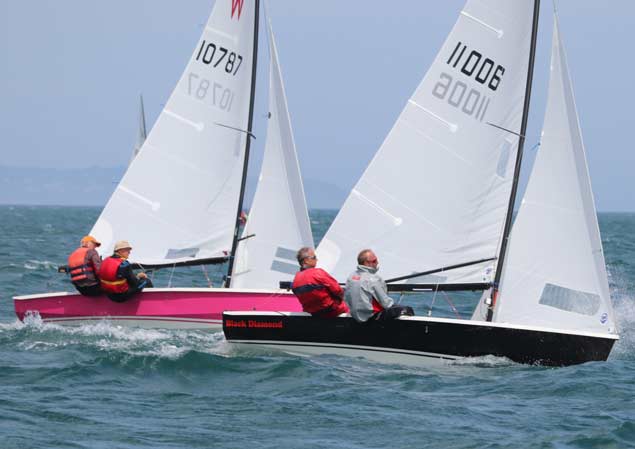 Beware. The Danes are on the coast……Stephan Nandrup-Bus of Herselve Strand Sailing Club in Denmark, crewed by Hans Wiggens Hansen in 11006, looks to have things comfortably in control off Greystones over clubmate Jan Kjeldsen crewed by Jorgen Blitzer in 10797. But in the end, Kjeldsen was 9th overall while Nandrup-Bus was tenth. Photo Alan Jones
Beware. The Danes are on the coast……Stephan Nandrup-Bus of Herselve Strand Sailing Club in Denmark, crewed by Hans Wiggens Hansen in 11006, looks to have things comfortably in control off Greystones over clubmate Jan Kjeldsen crewed by Jorgen Blitzer in 10797. But in the end, Kjeldsen was 9th overall while Nandrup-Bus was tenth. Photo Alan Jones
In fact, they almost won the Wayfarer Worlds at Greystones in July. Mogens Just and Anders Frils from Kalovig Badelaug in Denmark won the first race, and they logged two more wins and a second and third before being pipped at the post by the legendary sailmaker Mike McNamara of Rollesbury Broad SC in the heart of England’s Norfolk Broads, crewed by Simon Townsend.
Sailing Wayfarers keeps you young – Mike McNamara is reputedly 76, but his performance afloat belies it, and his performance to finish with a final score of 7 points to the 8 of Mogens Just said most things. Yet despite his Irish name, it couldn’t be claimed as a home win, for he operates as the sixth generation of sailmakers in the family firm, and six generations away from the McNamara heartlands around Lisdoonvarna and Ennistymon in north Clare is a very long time indeed.
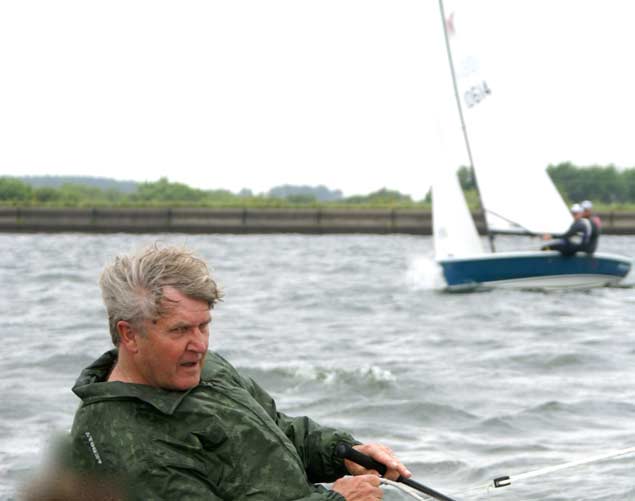 “My name is McNamara, I’m the leader of the band….” At the age of 76, veteran sailmaker Mike McNamara became the 2019 Wayfarer World Champion by just one point from Mogens Just of Denmark.
“My name is McNamara, I’m the leader of the band….” At the age of 76, veteran sailmaker Mike McNamara became the 2019 Wayfarer World Champion by just one point from Mogens Just of Denmark.
But at Greystones while McNamara and Townsend may have won by one point from the Danish Just/Fris crew, although two UK helms – Andrew Whitney and Bill Wilson – were next in line, the Danes then took seven places in a row in the shape of Niels Aislev (5th), Bjarne Lindquist (6th), Christian Elkjaer Iverson (7th), Christian Milert Hansen (8th), Christian Milert Hansen (9th), Jan Kjeldsen (10th) and Stephan Nandrup-Bus (11th), making it the most successful yet friendly Viking invasion on the Wicklow coast in a long time which the Irish had to accept gracefully, our best place being first in the Silver Fleet for the host club’s John Turner and Ken Lee, but in a fleet of this calibre that made them 15th overall. Full results here
Just to look back on the photos of the sunlit Wayfarer Worlds at Greystones in July is a real tonic after the cold and heartless weather of August. But for this weekend’s multi-dimensional Greystones Regatta – sponsored by BJ Marine and in association with Taste of Greystones - the seemingly unstoppable Greystones good fortune looks like returning with Indian summer conditions, and everyone is mad keen to make the best of it at this jewel of the Wicklow coast.
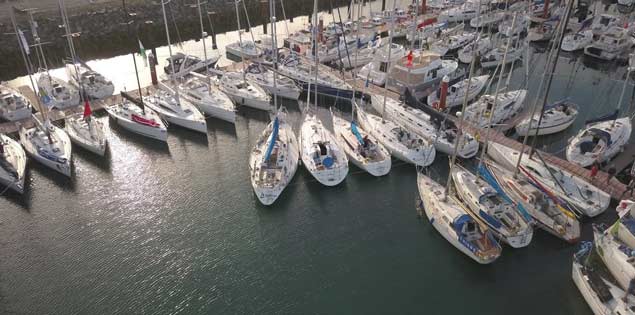 It’s regatta time, so they pack them in for sociable berthing in Greystones
It’s regatta time, so they pack them in for sociable berthing in Greystones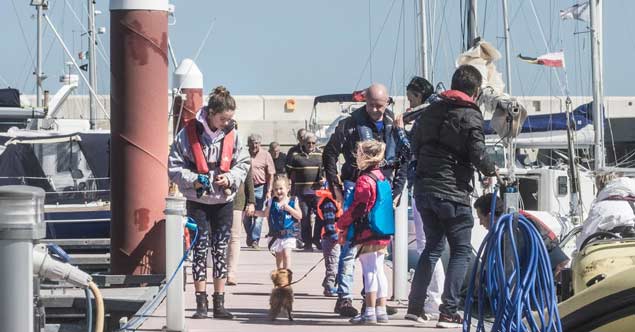 And the pooch comes too. The BJ Marine Taste of Greystones Regatta Weekend may see some serious racing, but it’s a family event as well
And the pooch comes too. The BJ Marine Taste of Greystones Regatta Weekend may see some serious racing, but it’s a family event as well
It is certainly rating very high with the cruiser-racing crowd, for the success of Greystones’ own Frank Whelan with his young crew on the keenly-campaigned Grand Soleil 44 Eleuthera - for two years and more now - brings heightened respect for the entire Greystones sailing scene. The word is that at least two of the classic Half Tonners associated with Howth – Dave Cullen’s Checkmate XV and Nigel Biggs’ Checkmate XIII - are going to make a proper weekend of it, while ISORA’s time-honoured annual James C Eadie Cup Race is being tailored in such a way that the leaders, having started in Dun Laoghaire at 1000 hrs, should be getting to the finish line at Greystones around 1600hrs this afternoon in an updated version of the ISORA feeder race which last year was won by Chris Power Smith’s J/122 Aurelia.
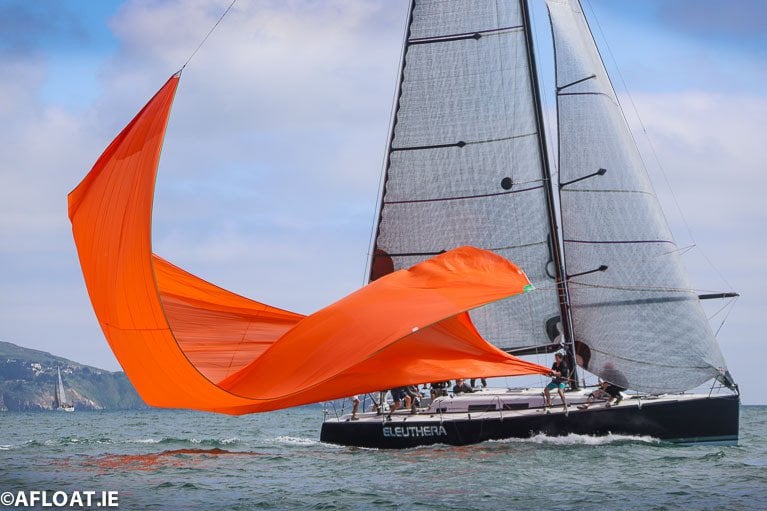 Champion for Greystones – Frank Whelan’s Grand Soleil 44 Eleuthera (GSC) on her way to one of many race victories in 2019. Photo Afloat
Champion for Greystones – Frank Whelan’s Grand Soleil 44 Eleuthera (GSC) on her way to one of many race victories in 2019. Photo Afloat
Meanwhile the Dublin Bay Sailing Club fleet will be limbering up towards their usual Saturday starting sequence around 1400 hrs, but in this instance the finish will be at Greystones, bringing upwards of 70 boats from Dun Laoghaire, while additional feeder races from both Clontarf Y & BC and Poolbeg Y & BC will make Greystones Harbour a distinctly busy and convivial place this (Saturday) night.
Tomorrow (Sunday) the hope is to fit in two races with a reasonably early conclusion in five classes under ECHO, making it a hectic weekend for the volunteer element in Greystones SC, for the club’s total membership is around the 360 mark. The demand for the proper Committee Boat starting line means that Daragh Cafferky won’t be able to race his own A35 Another Adventure (just back from a “hugely enjoyable” visit to West Cork and Calves Week), as Another Adventure has to serve as Committee Boat, but needs must.
Last year Pat Kelly’s J/109 Storm from Rush and Howth was top boat overall and winner of Class 1 to win the Taste of Greystones Trophy, with second OA going to sister-ship White Mischief (Tim Goodbody, RIYC), while Dermot Cafferky’s Another Adventure was allowed at the racing in 2018, and was rewarded with third overall.
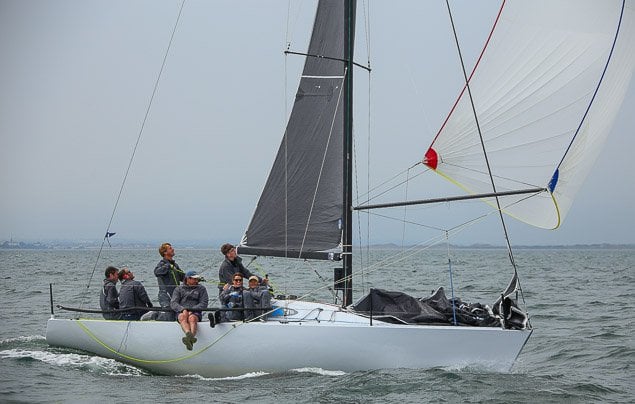 Nigel Biggs’ classic Half Tonner Checkmate XVIII was winner of Class 2 sailed by Ronan Keating at Greystones Regatta 2018. Photo: Afloat.ie/David O’Brien
Nigel Biggs’ classic Half Tonner Checkmate XVIII was winner of Class 2 sailed by Ronan Keating at Greystones Regatta 2018. Photo: Afloat.ie/David O’Brien
Class 2 went to Checkmate XVIII, while James Kirwan’s First 36.7 Boomerang of RStGYC and Greystones was second and local boat Virgin Triangle (Graham Noonan) took third. In Class 3, Brendan Foley’s impressively-optimised Impala 28 Running Wild (RStGYC) won out from Barry Cunningham’s Quarter Tonner Quest (RIYC) while Luke Fegan’s Hustler 32 Smokehaze, all the way down from Malahide, was third.
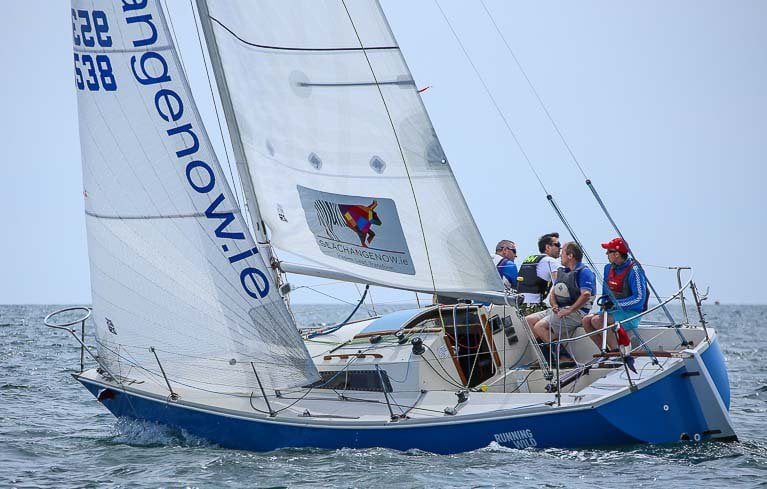 Brendan Foley’s impressively optimized Impala 28 Running Wild (RStGYC) took the Class 3 title at Greystones last year. Photo: Afloat.ie/David O’Brien
Brendan Foley’s impressively optimized Impala 28 Running Wild (RStGYC) took the Class 3 title at Greystones last year. Photo: Afloat.ie/David O’Brien
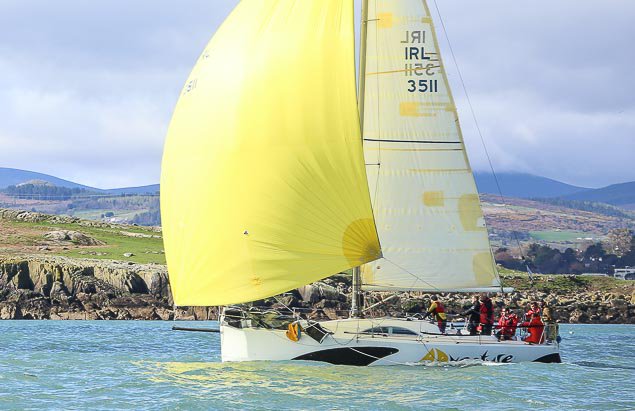 Daragh Cafferky’s A35 Another Adventure was on the podium at the 2018 Greystones Regatta, but this weekend she is doing duty as Committee Boat. Photo: Afloat.ie/David O’Brien
Daragh Cafferky’s A35 Another Adventure was on the podium at the 2018 Greystones Regatta, but this weekend she is doing duty as Committee Boat. Photo: Afloat.ie/David O’Brien
In White Sails Class 4, the Byrne family’s Jeanneau 34 Alphida from Howth was tops with Elantic (C Allen, Arklow SC) second and the Greystones boat Run’n’L8 (C McGuire) third, while in White Sails Class 5 J Raughter’s Chase Me from Bray took the title from E Lynch’s Alfresco from Wicklow, with another Bray boat, Fegan’s Nymadzi, getting third.
The impressive range of the prize winners’ home ports, from Arklow in the south to Malahide in the north while including every sailing centre in between, speaks volumes about what a marvellous celebration of East Coast sailing and its shoreside hospitality the Taste of Greystones has become.
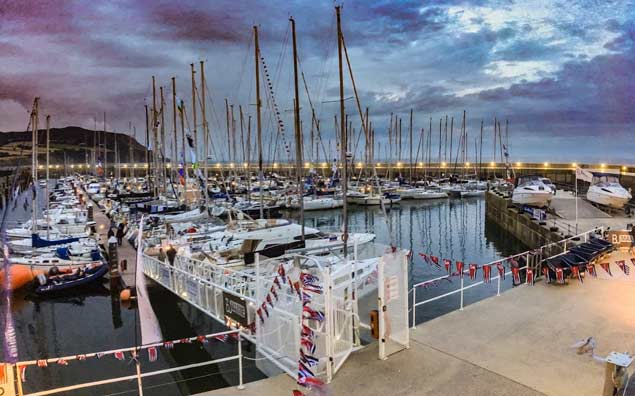 Regatta evening – the day’s sport is complete, and the harbour is full
Regatta evening – the day’s sport is complete, and the harbour is full
Yet just to show that this weekend’s popularity of Greystones Harbour isn’t a flash in the pan, in a week’s time the Irish Cruising Club will be holding its Annual East Coast Rally at Greystones, while thanks to the foul weather of mid-August, the annual Greystones Junior Regatta originally scheduled for August 18th had to be postponed, and is still something to be keenly anticipated.
And as a continually repeated theme underlying all sailing and boating, there is now the enduring fact that Greystones has become a very useful port of call for cruisers as they make their quiet way up and down the coast. Those of us with a taste for the East Coast for a long time always had to admit that while it was beautiful to look at and sail along, you were distracted from enjoying its beauty by concerns about how far it was to the next safe haven, particularly if the weather was acting up. The arrival of Greystones Marina has been transformative. We can only hope that its success will encourage other currently inadequate East Coast ports to see where their best future is to be found.
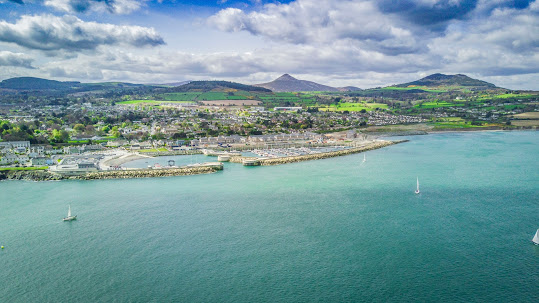 This weekend, Greystones is the focal point for East Coast sailing, and an example for other harbours in need of development
This weekend, Greystones is the focal point for East Coast sailing, and an example for other harbours in need of development


























